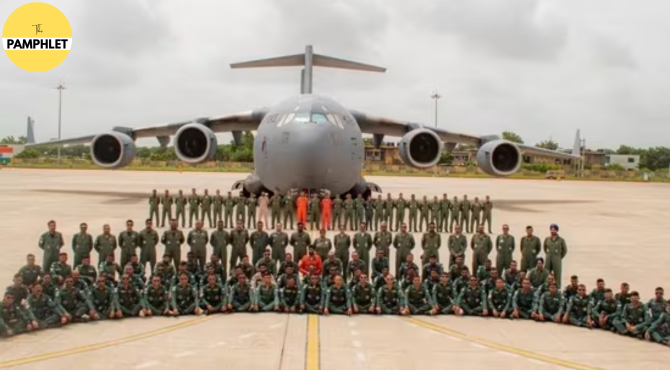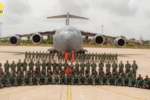India’s recent issuance of a Notice to Airmen (NOTAM) alerting to airspace restrictions along the Pakistan border between October 30 and November 10 marks more than a routine military exercise. It is a calculated display of operational maturity, reflecting both strategic restraint and silent confidence in the aftermath of Operation Sindoor.
Satellite imagery shared by geo-intelligence experts first revealed India’s large-scale NOTAM warning, with the designated area and scope of the exercise described as “unusual” for its expanse and altitude — extending up to 28,000 feet. The Ministry of Defense later confirmed that this will be part of Exercise Trishul, a tri-services drill involving the Army, Navy, and Air Force.
A trident of readiness
“Trishul”—aptly named after Lord Shiva’s weapon, symbolizing power, precision, and balance- captures India’s modern defense doctrine. The decision to hold such an integrated exercise in the middle of the desert, across the country’s western front, is a deliberate signal.
It demonstrates that the Indian Armed Forces possess not only numerical strength but also tactical agility — the ability to operate across every terrain, from the Thar desert to the Saurashtra coast, and from deep-sea amphibious zones to high-altitude airspaces.
While official briefings frame it as a validation of “jointness” and “Atmanirbharta,” the timing is unmistakably significant. Operation Sindoor — launched in May as a precision retaliation to the Pahalgam terror attack — altered the security dynamic between India and Pakistan. It marked the deadliest confrontation in decades and redefined India’s threshold of tolerance. Now, just months later, Exercise Trishul underscores the country’s commitment to remain ready for any contingency without saber-rattling.
From response to readiness
India’s tri-services coordination has evolved considerably over the past decade. The push for integrated theatre commands and the establishment of joint logistics nodes have laid the foundation for exercises like Trishul. This particular drill, with the Southern Command’s active participation, will validate offensive maneuvers in desert and creek sectors, amphibious operations off the western coast, and complex multi-domain warfare involving cyber, electronic, and intelligence components.
In simpler terms, Trishul is India’s answer to modern warfare’s central question: can the nation’s military arms act as one?
The post-Sindoor environment has infused a new clarity into India’s strategic posture: that deterrence is not built on rhetoric but on readiness. The desert, often symbolizing barrenness, here becomes the stage for India’s preparedness — proving that geography is no constraint to capability.
Atmanirbharta in action
Beyond the operational optics lies a deeper structural message: India’s defense ecosystem is maturing. The emphasis on indigenous systems during Exercise Trishul is not mere symbolism. The first batch of BrahMos missiles manufactured in Lucknow, the steady induction of Indian-made drones, and the growing reliance on homegrown electronic warfare systems all tie back to the government’s broader vision of Atmanirbharta in defense.
Defense Minister Rajnath Singh, while addressing soldiers in Jaisalmer earlier this week, hinted at this very linkage. “Pakistan will now think twice before attempting any misadventure,” he remarked — not as provocation but as assertion of deterrent credibility. The statement carried the calm weight of someone speaking from experience — from the operational confidence that Sindoor created and Trishul now consolidates.
The strategic message behind NOTAM
Every NOTAM carries both tactical and psychological weight. To the aviation community, it is a safety advisory. To strategic observers, it is a message in plain sight. A NOTAM of this scale, encompassing airspace adjacent to Pakistan, tells its own story — one of controlled signaling. It reminds adversaries that India’s preparedness is constant, not circumstantial.
Unlike wartime alerts, such exercises project strength without escalation. The precision of timing — post-Sindoor, yet pre-winter — ensures operational testing under challenging conditions, while also signaling to both domestic and international audiences that India’s military reforms are not just theoretical frameworks but living, breathing systems.
Calibrated confidence, not chest-thumping
There is a noticeable tonal difference between India’s strategic communication today and in previous decades. Gone are the days when border exercises were interpreted as provocations or symbolic shows of power. Today, they form part of a mature defense posture — one that blends assertiveness with restraint.
Exercise Trishul exemplifies this shift. It is not a reaction; it is preparation. It is not an answer to Pakistan’s rhetoric; it is a reflection of India’s self-assurance. The exercise is neither saber-rattling nor strategic theatre — it is quiet strength, expressed through coordination, innovation, and indigenization.
Conclusion: Beyond the desert horizon
As the sands of Rajasthan shimmer under the autumn sun, India’s military machine will test its synergy across air, land, and sea. Behind every maneuver and missile simulation lies a deeper story — of a nation learning to fight smarter, not louder; to integrate, not imitate; and to rely on its own innovation instead of imported intent.
In the long run, Exercise Trishul will not just validate joint operations — it will validate a national mindset shift.
A shift from reaction to readiness, from import to innovation, and from uncertainty to unshakable assurance.
And in that sense, the NOTAM is not merely a warning to the skies — it is a quiet declaration to the world: India is ready, anywhere, anytime.









